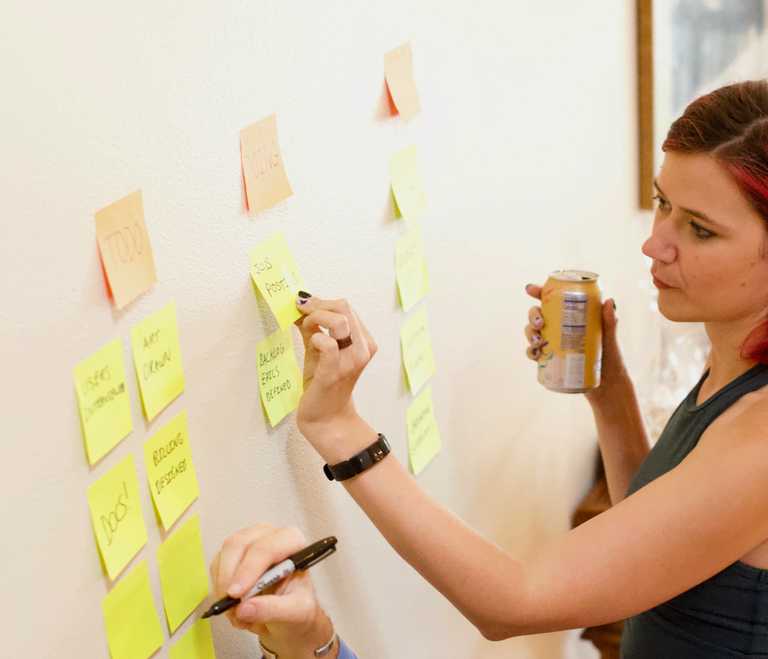Scrum vs. Kanban - Key Differences
Scrum methodology provides teams with the structure and schedule for project management, while Kanban embraces visual-based project management. Find out more about the key differences in this article.

Scrum and Kanban are two popular project management methodologies followed by Agile teams. Both these methodologies emphasize completing project tasks incrementally, focusing on continuous collaboration, feedback, and improvement. While Scrum is more related to assigning roles and timelines for each iterative delivery cycle, Kanban centers around visualizing tasks and providing more flexibility in management. Since both Scrum and Kanban are widely used project methodologies, new Agile teams are often confused about which one to pick. Therefore, this article provides a comprehensive overview of Scrum and Kanban and lists the key differences you should know to pick the right methodology.
What is Scrum?
Scrum is a project management methodology that manages software development through an iterative approach. It breaks down the development process into time-bound iterations or Sprints, usually lasting 1-4 weeks. Every Sprint in Scrum targets to deliver a functional increment of the product. There are three main pillars of Scrum, i.e.:
- Adaption – Embraces changes
- Transparency – Encourages trust and quality
- Inspection – Promotes a culture of improvement
The Scrum framework comprises predefined roles, including the Product Owner, Scrum Master, and Development Team. Moreover, Scrum contains specific events, such as Sprint Planning, Daily Stand-up, Sprint Review, and Sprint Retrospective, executed repeatedly throughout development.
Scrum emphasizes self-organization and cross-functional teams. It encourages collaboration, transparency, and a focus on delivering value to the customer. Besides that, the methodology promotes regular inspection and adaptation, empowering teams to respond effectively to changing requirements and business needs.
How Does Scrum Work?
Scrum works in a structured framework involving different goal-oriented events for effective project management. The process starts when the Product Owner creates the product backlog, which includes the list of prioritized tasks (desired features, bugs fix, and enhancements for the product). Afterward, the development team estimates the efforts required to complete the backlog using an estimation technique, like Planning Poker, Async Poker, the Bucket System, Dot Voting, etc.
Before beginning the Sprint, the Scrum team conducts a Sprint Planning meeting to select the high-priority items from the product backlog to work on during the Sprint. Afterward, the time-boxed Sprint, usually lasting 2-4 weeks, begins in which the development team completes the objectives of the Sprint. During Sprint, they also conduct Daily Stand-up meetings to ensure coordination, discuss progress, and identify challenges.
Once the Sprint is completed, a Sprint Review meeting takes place. In this meeting, the development team presents the completed work to stakeholders and gets their feedback. Lastly, the team conducts a Sprint Retrospective meeting, which helps the team to see what went well in the Sprint, what can be improved, etc.
All the above steps continue repeatedly until all the product backlog items are completed.
What is Kanban?
Kanban is a visual approach to project management that makes it easy to track tasks. The main component of Kanban is the Kanban board, digital or physical, which includes multiple columns to divide the project phases, such as To Do, In Progress, and Done. The tasks are written on cards that flow from one column to another until all cards reach the last column.
The phrase "Kanban" means "signboard" in Japanese. This method was first utilized in the Toyota factory, where cards were used to track the production progress. Today, Kanban is used in many other industries, such as software development, manufacturing, etc.
Some of the common terms used in Kanban include:
- Work in Progress (WIP) Limits: WIP limits help the team to set a limit on the entire board or specific columns. So, a WIP limit of five in a column means that the column cannot have more than five cards at a time. This way, the WIP limit helps to streamline development and detect challenges in the production process.
- Definition of Workflow (DoW): The DoW sets the definition of key elements of the Kanban workflow, such as what "started" and "finished" means, how much time it takes for one task to pass through all the columns, etc.
- Kaizen: Kaizen means "improvement" in Japanese. It is about having a continuous improvement mindset so that the team members can collaborate, share insights, and improve their outcomes.
Kanban has helped teams increase transparency in the project by visualizing the position of tasks and identifying bottlenecks. It helps to improve the delivery speed and ensures that business objectives are aligned with the delivered work.
How Does Kanban Work?
Kanban-based project management revolves around the Kanban board and Kanban cards. In fact, the Kanban board is the center point of all activities in Kanban. It can be a physical or digital board, depending on the team's choice. The board's purpose is to set up a standard workflow, visualize the work in progress, and identify bottlenecks. It is mainly divided into three columns, i.e., To Do, In Progress, and Done. However, there can be more columns as well.
Besides the Kanban board, there are Kanban cards. Each card represents one task. At first, the cards are placed in the "To Do" column. It is not necessary that the team places all the cards in the To Do column at once. They can place a few top-priority cards at first and then gradually add new ones to the column as the development proceeds.
Once the team starts working on the first card, it is shifted to the "In Progress" column. After the task is completed, the card is shifted to the "Done" column. The process continues until all cards reach the final column. This way, Kanban makes task visualization much easier and helps the team manage its workflow efficiently.
Common Aspects in Scrum and Kanban
Scrum and Kanban are both Agile methodologies used by development teams to carry out project management effectively. Below are some common similarities between the two methodologies:
- Small incremental-based project tasks completion.
- Teams are cross-functional and self-organized.
- Teams embrace internal and external feedback to adapt to the changing requirements.
- Team collaboration is essential for mutual understanding and idea sharing.
- Work prioritization is based on the business value and customer demand.
- Transparency is valued to ensure quality deliveries with continuous improvement.
- Follow an empirical process control approach where decisions are based on actual observations, data, and feedback.
- Promote a continuous delivery mindset.
In short, there are many similar aspects between Scrum and Kanban, which even encourages teams to use them combined, called Scrumban. It is a hybrid model that utilizes the visualization tools of Kanban and the processes of Scrum.
Key Differences Between Scrum and Kanban
Now that we have looked into the basic concepts of Scrum and Kanban, along with their similarities, let's shift our focus to what specific aspects differentiate both these methodologies. Therefore, below is a quick overview of the ten key differences between Scrum and Kanban:
1. Structure
Scrum is a well-structured framework that involves a fixed team structure and fixed development approach. Every Scrum team includes a Product Owner, Scrum Master, and Development Team, while the development is based on fixed events and principles. In short, everything is very structured in Scrum.
In contrast, Kanban is a less-structured framework that empowers anyone to make changes in the cards and move them across board columns. This way, there is a higher level of freedom in Kanban. The only fixed thing in Kanban is work-in-progress. Moreover, Kanban is capable of adapting to changes faster and right away.
2. Roles and Responsibilities
Scrum is all about roles and responsibilities. Every Scrum team member has a predefined role. For instance, the Product Owner's role is to define and prioritize the product backlog, while the Scrum Master's role is to facilitate the Scrum process. This way, Scrum keeps a well-established framework of roles and responsibilities.
On the other hand, Kanban has almost no pre-defined roles. It emphasizes collaboration and shared responsibility among teammates to complete tasks and optimize the workflow. It might include some members with specific responsibilities or expertise, but mainly it's a collective effort.
3. Changes
Scrum emphasizes a lot on implementing changes in a planned way. It begins with Sprint Planning and ends at Sprint Retrospective. During this whole process, there are many meetings that help the team to collaborate and finalize the improvements/changes they will implement in the next Sprint.
In Kanban, changes are implemented on the go. Whenever the team thinks of the need to make some changes in the workflow or process, they can make adjustments immediately. Kanban promotes a culture of continuous improvement, where team members are empowered to suggest and implement changes as they see fit.
4. Delivery Timelines
Scrum delivers incremental product updates after every Sprint. The due date is linked with the time duration of the Sprint, such as 2 weeks or 4 weeks.
Kanban delivers products or specific features of products continuously on an as-needed basis. The due date is set according to the complexity of the task. The "To Do" section is continuously updated with the new set of tasks that teams have to complete.
5. Measuring Success
Scrum measures success by the backlog completion speed. Moreover, Scrum measures production based on the velocity of each Sprint, i.e., the amount of work a team can handle in a Sprint. The success of the next Sprint is highly linked to the success of its predecessor. So, when all Sprints are executed timely without requiring any extension, then that project is considered successful.
Kanban has a different metric to measure success. The success of a project with Kanban is linked with the cycle time, which reflects the total time it takes to complete the project entirely. Besides that, teams can also use work-in-progress (WIP) and throughput metrics.
6. Improvisation
Once a Sprint is started, Scrum does not provide any room for improvisation. No matter how beneficial improvisation can be, it cannot occur during the Sprint. Scrum welcomes improvisation during other Scrum events, such as Sprint Planning, Sprint Review, or Sprint Retrospective events.
Kanban values improvisation and allows for adjusting the development cycle whenever the team wants.
7. Required Experience
Being a structured and roles-driven methodology, Scrum is best suited when team members are familiar or experienced with it. Therefore, recruits can find it challenging to use effectively.
Kanban is a more straightforward methodology that is easy to understand and use. This makes it a more friendly technique for non-experts who want to utilize Agile methodologies without requiring significant prior experience and time.
8. Task Prioritization
In Scrum, the Product Owner creates a prioritized product backlog, which the team uses during Sprint Planning to take the top priority tasks for the Sprint. This way, Scrum uses the pull system, which pulls the entire batch for each Sprint.
Kanban also uses the pull system, but the team pulls new tasks only when the previous tasks are completed. So, it's an individual task-level pull system compared to the batch-level pull system of Scrum.
9. Application
Scrum is best suited when the backlog contains specialized tasks and is dealt with by only one team. So, a project with fixed deliverables, specific goals, or a limited timeframe is very well executed with Scrum. However, it does not mean that Scrum cannot acknowledge changing priorities. Its Sprint Review and Retrospective events are meant to address the feedback and new requirements in the upcoming Sprints.
In contrast, Kanban is best suited for projects where the priorities are not clearly defined and can get changed abruptly. Long-term projects involving multiple teams and the need to continuously adapt to changing priorities can find Kanban helpful.
10. Work Estimation
Scrum teams estimate the product backlog to have a mutual understanding and prioritize the backlog effectively. Estimation in Scrum mainly focuses on knowing the effort required to complete tasks using any popular estimation technique, like Async Poker, T-Shirt Sizing, Planning Poker, etc. This helps the team know how much work it can handle in a Sprint, which makes it easy to shortlist the tasks during Sprint Planning.
Kanban emphasizes breaking large tasks into smaller tasks. It does not require estimating the pending tasks. Instead, it uses the previous lead time, throughput data, and cycle time to forecast how much work the team can complete in the future based on the predefined period.
Wrapping Up – Scrum vs. Kanban: Which Should You Choose?
Scrum and Kanban have made their name as effective project management approaches in the current fast-paced era. However, we cannot make anyone the winner, as it depends on the specific needs of the project or team.
Scrum is a structured methodology well-suited for complex project requirements and organized teams. It emphasizes regular planning, collaboration, clear roles/responsibilities, and continuous review sessions. On the other hand, Kanban is well-suited for predictable workflows and a flexible team. Its emphasis on visual management allows for easy tracking of work items, ensuring transparency and promoting effective communication.
Overall, there is no one-size-fits-all answer. You should evaluate the project requirements and your team dynamics to finalize which methodology you want to use. Alternatively, you can utilize both methodologies together, i.e., Scrum for development and Kanban for visualization.


